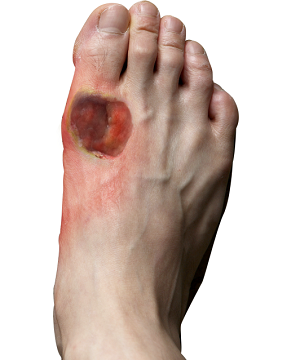
Diabetic Foot
-
Are you having high diabetes?
-
Does an injury to either of the feet taking longer than usual to recover?
-
Has your foot changed its colour over a period of time?
If yes, then it is time to seek help of diabetic foot specialist!
What is Diabetes Foot?
If the blood-sugar or blood glucose level of your body is too high then it can damage your nerves or blood vessels.
Nerve damage caused because of high diabetes (Neuropathy) can lessen your ability to feel pain means you may not notice a cut or a blister or sore in your feet until it becomes infected. Less Blood supply because of damage to blood vessels means foot infections/ulcer takes longer time to heal which is called as diabetic foot.
These infections may be superficial skin infection (cellulitis) to deep bone infections (osteomyelitis).
Potential Complication of Diabetes Foot
Damage of blood vessels may also mean that feet are not getting ample oxygen and blood and hence injury may take longer to heal. Infections that do not heal can cause skin and tissue to die, also known as gangrene. The dead tissue turns black and the entire foot gets discoloured. To stop further spread of infection treatment can involve surgery to remove a toe, foot, or part of a leg (amputation).
It is always important to recognize early warning signs of foot problems in order to address the ailment at the earliest. Here are some of the symptoms that diabetes foot comes with. You need to look out for:
-
Burning, tingling, or painful feet
-
Loss of sensation of heat, cold, or touch
-
Changes in colour or shape of your feet
-
Loss of hair on the toes, feet, and lower legs
-
Thickening and colour change (yellow) of the toenails
-
Onset of blisters, sores, ulcers, infected corns, or ingrown toenails
-
Cracking of the skin of the feet, especially the heels, due to dry skin
Contact your doctor if your symptoms get worse or you experience any of the following:
-
Your leg looks pale or blue
-
Your leg becomes cold
-
Chest pain accompanies leg pain
-
Your leg becomes red, swollen, or hot
-
New sores or ulcers develop and do not heal
-
You experience fever, chills, weakness, or other signs of infection
How to Avoid Losing Foot (Amputation) in Diabetes Foot?
To decrease the possibility of an amputation, you must understand the causes that lead to amputation. You can avoid amputation of diabetes foot by following three main ways of prevention; primary, secondary and tertiary.
Primary prevention (Prevention of Diabetes foot):
Includes stopping wounds before they happen.
- Life style Modification:
- Good management of your diabetes:
- Foot care regimen for Diabetes Foot:
- Secondary Prevention
Stop smoking
Follow a regular exercise program that includes walking
Eat a balanced diet with proper nutrition
Lose weight
Treat conditions such as diabetes, high blood pressure, or high cholesterol
Regular monitoring of blood sugar level (HBA1C), regular exercise, balanced diet rich in fruits and vegetables, and regular medical exams.
Do not smoke. Smoking damages blood vessels and decreases the ability of the body to deliver oxygen. In combination with diabetes, it significantly increases your risk of amputation.
Check your feet every day.
Wash your feet every day with water. Check temperature with your hand first. Pat foot with towel rather than rubbing vigorously.
Use lotion or moisturiser to keep the skin of feet soft and moist to avoid dry skin cracks.
Tim your toenails regularly. Avoid cutting corners, Use a nail file.
Visit surgeon if you find in grow toenail
Never walk barefoot as nerve damage reduces sensation.
Wear protective well cushioned shoes.
Protect your feet from hot and cold.
Wear loose socks to bed
Avoid sitting with crossed legs or standing in one position for a long time.
Includes healing of wounds quickly.
Standard Surgical therapies to speed wound healing may be provided by diebetic foot specialist
High blood sugar (hyperglycemia), high blood pressure (hypertension), and high cholesterol (hypercholesterolemia) are to be controlled.
Smoking damages blood vessels and decreases the ability of the body to deliver oxygen. In combination with diabetes, it significantly increases your risk of amputation
Education on basic foot care, and proper footwear, to prevent blisters and wounds is crucial, as are regular foot exams by a doctor
Tertiary Prevention
Includes correcting of severe problems to avoid amputation.
Our Specialist

Dr. Nitish Jhawar
M.S., FMAS, FIAGES, FALS, FACRSI
Fellow Advance Laparoscopic Surgery
Fellow Colorectal Surgery USA
Senior Laparoscopic & Colorectal Surgeon
Phone No: +91 9322 229 159
Email Id: info@neoalta.com


